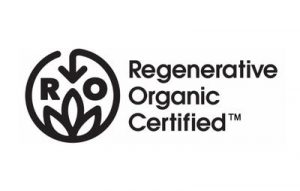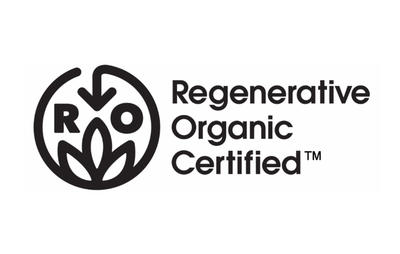
New certification alliances continue to push the boundaries for what consumers can expect from product labels. Most recently, the Regenerative Organic Alliance has come together to launch the Regenerative Organic Certification (ROC) in the spring of 2018.
You may ask, “Another certification? Will that be confusing or overwhelming for customers?” A valid question, but the the Regenerative Organic Certification aims to be an all-encompassing standard that would simplify packaging while addressing social, environmental and economic concerns.
This post will illuminate the motivation behind the Regenerative Organic Certification, and some features that differentiate the ROC from other efforts.
Why do we need another certification system?
Led by the Rodale Institute, the ROC emerged in reaction to recent controversies surrounding the definition of organic.
The Organic Foods Production Act (OFPA), passed in the 1990 Farm Bill, created a national organic standards system. ‘Organic’ is a labelling term that indicates compliance with OFPA standards. According the the OFPA, the USDA is responsible for developing and writing regulations, guided by the National Organic Standards Board (NOSB). The issue is that the USDA definition of organic is broad and subject to debate and lobbying pressure.
Additionally, the entire National Organic Program is part of the USDA Agricultural Marketing Service. The explicit objective of the service is to create domestic and international marketing opportunities for farmers, and as a result there is a legitimate argument that health and environmental concerns are beyond the scope of its jurisdiction.
This argument is precisely why the organic standards have been compromised from their original vision. Since the early 2000s, when the organic rules were fully implemented, there has been lobbying pressure from industrial agribusiness eager to enter the market, which has shaped the decisions of the NOSB.
Some particularly salient controversies have been in the press in the past few years: the inclusion of soil-less farming (namely hydroponics) under the USDA Organic label and the cancelling of an animal welfare compliance rule by the Trump administration.
The organic community was outraged by both decisions, feeling as though they had “lost the helm.”
As a result, several solutions have been proposed to re-legitimize the organic name. There is a political push for additional funding and increased control of the National Organic Standards Board. And, eager for change, researchers, farmers and industry leaders have decided to tackle the problem themselves with the introduction of new certification processes by the non-profit sector.
Two models are currently being proposed: an organic add on label that would appear with the USDA Organic label; and the Regenerative Organic Certification (ROC), which aims to encompass the organic label and several others. The add-on label has yet to formalize, but the ROC already has momentum.
What is unique about the ROC?
Comprehensiveness

Rather than contributing another certification label to the marketplace, the ROC is an ambitious and admirable attempt to encompass the standards of a multitude of other labels. The baseline for entry into the ROC process is a USDA Organic or equivalent certification. Additionally, producers must meet animal welfare and social fairness requirements for one of the many certifications, for instance Certified Humane, Animal Welfare Approved, Fairtrade and Fair for Life.
A focus on soil health and climate change
The ROC focuses on soil health as a means of regenerating the soil, improving ecosystem function, and mitigating climate change.

Adding carbon to soils promotes healthy soil functioning by building soil carbon and feeding the soil biology that keeps the system in balance. Common regenerative practices that build soil health and sequester carbon are composting, cover cropping, low-till or no till practices. Regenerative farming practices increase the long term viability of any farming or ranching practice.
Furthermore, as shown in research by the Rodale Institute and others, there is potential to mitigate climate change in agricultural soils by sequestering carbon dioxide from the atmosphere.
Fortunately, the principles behind regenerative methods are becoming mainstream with recognition from the USDA and through media outlets. As a result, public policy incentives may formalize to encourage farmers toward these practices. At the state level, ‘carbon farming’ or ‘regenerative farming’ legislation is proposed in states including HI, OK, MD, MA, NY, CA and VT.
An all-star governing body
The ROC governing body, the Regenerative Organic Alliance, is an impressive list of leaders from the organic and environmental movement.
Members include representatives from iconic organic organizations like the Rodale Institute, the non-profit agriculture research center that was founded by the “father of the organic movement,” and Demeter, which launched the first organic certification.
Additionally, the Alliance has representatives from diverse credible certification programs like Compassion in World Farming, the Fair World Project and Textile Exchange, as well as leaders from the sustainable farming community from White Oak Pastures and Grain Place.
Importantly, the Regenerative Organic Alliance also includes industry leaders from Dr. Bronner’s and Patagonia.
Patagonia and Dr. Bronner’s are driving momentum
Patagonia is in many ways an innovator of Corporate Social Responsibility and is engaged in a wide range of social and environmental initiatives, many of which it pioneered. Importantly, Patagonia has already launched a certification initiative, 1% for the planet, which could help the ROC to avoid missteps and efficiently create a high-value market for members.
Dr. Bronner’s, a B Corps 2018 “Best for the World” brand for its environmental and social efforts, has launched a company-wide initiative to support the ROC. The initiative includes a limited edition “Heal Earth!” label on its best-selling product line that explains the pillars of the ROC standards. This effort aims to educate consumers on what the label means and why they should pay more.
This support is significant in raising awareness with consumers and in the corporate environment. Additionally, if companies require their producers to comply with the ROC, it could lead to widespread adoption of the certification. Many companies have already stated their allegiance to the values of the ROC.

What are the main challenges for the ROC?
The cost structure of the ROC is undetermined, i.e. it is unclear how much certification will cost, the cost of maintaining certification and who will pay for it. This could be a substantial hurdle for the movement. If producers are expected to pay the certification and maintenance costs, it will need to translate to higher-value market access.
This may be an achievable goal if the costs of certification are kept low for the producer by having them paid in part by the manufacturer, or through mutual recognition between certification labels through an overarching body like the ISEAL Alliance.
Another major challenge for the ROC will be communicating its meaning to consumers and differentiating from the USDA organic and other labels. The support from industry leaders should help with this challenge, but even those efforts will only reach a subset of the population.
Lastly, the concept of carbon sequestration in soils could sound strange to consumers unfamiliar with the carbon cycle and agricultural practices. Luckily, carbon farming is a concept that is increasingly discussed in the mainstream
The take-away
If you would like to know more about the ROC, I recommend the the Framework for Regenerative Organic Certification for detailed information, or the video produced by the Rodale Institute.
Ultimately, the ROC aims to take accountability and ‘organic’ to the next level in a thought provoking, admirable move toward social and environmental sustainability.
If you would like to support the ROC movement, check out if your state has carbon farming proposals, and of course, vote with your dollars!

